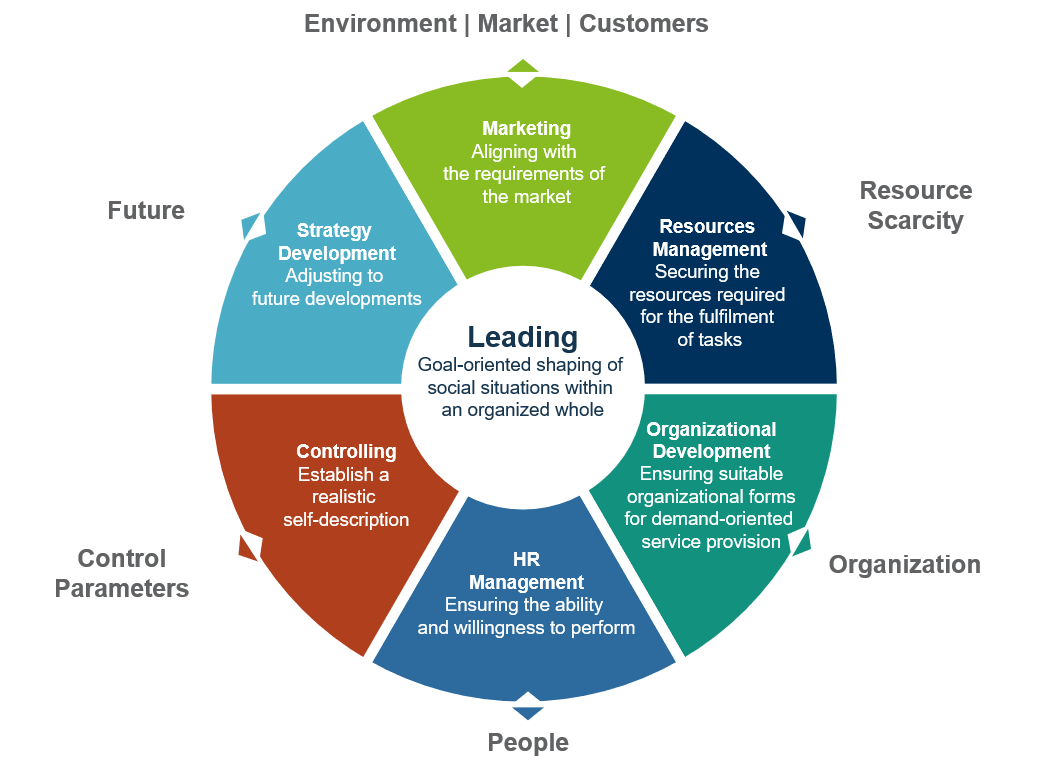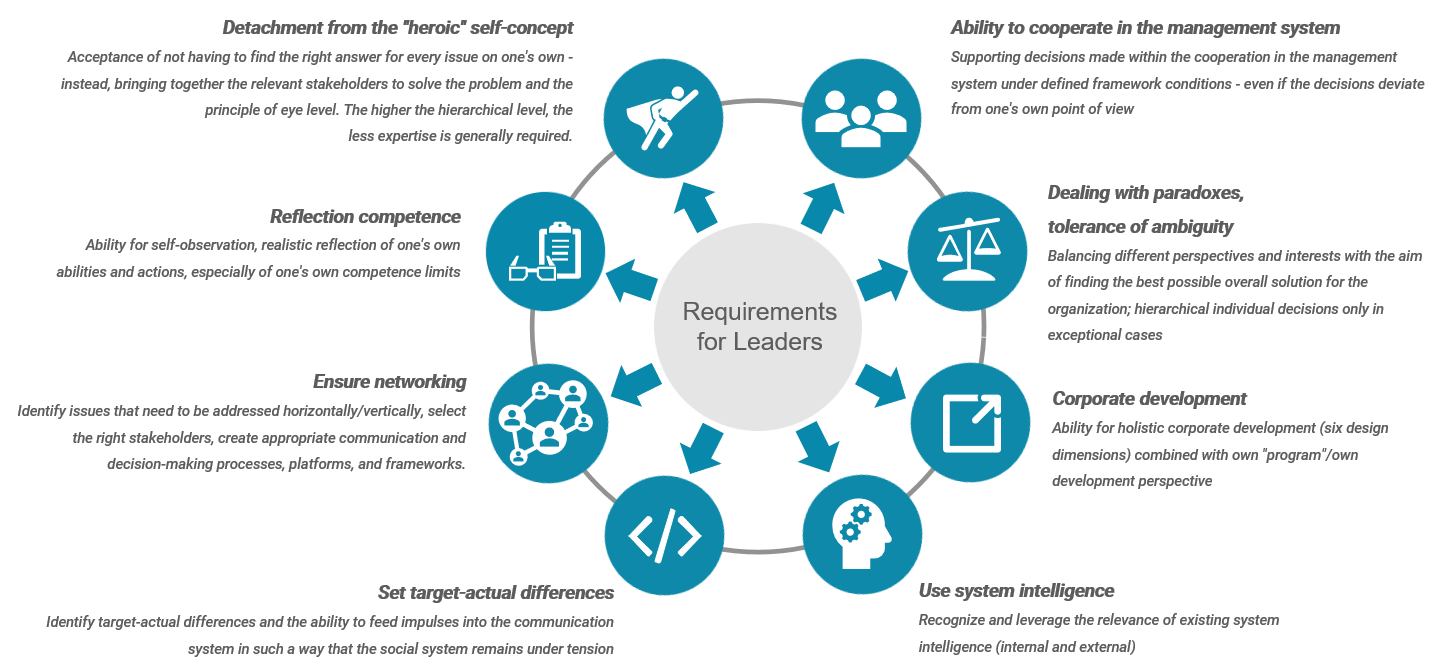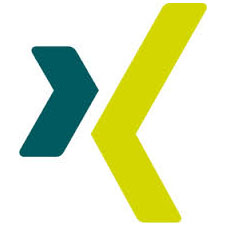The traditional understanding of leadership has become obsolete. The days of the heroic self-concept of leaders, according to which they themselves are the most important lever for maintaining order and efficiency in the organization, are over. Today's working world and the increasing complexity of markets require a different form of leadership.

The traditional understanding of leadership has become obsolete. The days of the heroic self-concept of leaders, according to which they themselves are the most important lever for maintaining order and efficiency in the organization, are over. Today's working world and the increasing complexity of markets require a different form of leadership.
Leadership - an organizational function
In systemic organizational consulting, we understand leadership as an organizational function that aims to ensure the future viability of the organization. In this context, leadership is not a phenomenon dependent on individuals, but can only fulfill its task through the effective interaction of different organizational functions, both horizontally and vertically.
Today’s working world and the increasing complexity of the relevant environments require a mix of analytical and social skills as well as reflection and assertiveness. The people involved are required to think carefully at all levels, to observe what is happening, and to generate useful impulses from these observations, which they then bring into the internal organizational communication process. In this way, an organization can strengthen its sensitivity to new requirements and other changes in the relevant environments, but also to current and potential disruptions within.
The traditional understanding of leadership has become obsolete
According to the traditional understanding of the organization, leadership has the task of ensuring the efficiency of the organization and minimizing “disruptive” personal influences of employees as well as other disruptive factors through measures such as incentive or sanction systems and further optimizing the existing processes. Leadership thus looks at what is happening “from outside” and draws its conclusions from its observations.
Traditionally, leadership comes from individuals and affects individuals. What counts are the personal characteristics and abilities, the “leadership qualities” with which the leaders mobilize their respective areas of responsibility in such a way that they achieve the specified goals. This is accompanied by a “heroic” self-concept on the part of the leaders: They have high expectations of themselves in terms of having their areas under control. In the event of deviations from the target or normal state, directive intervention prevails. Usually, the blame for missed targets or mistakes is attributed to individuals.
The traditional understanding of organization is based on the premise that a certain input basically produces a certain and thus expectable output. Under this premise, organizations can be compared to trivial machines in which the causalities for any deviations from expectations can be easily explained: with the lack of performance or willingness of acting persons, inefficiencies or errors in the existing structures or inadequate use of existing resources.
Here, complexity is strongly reduced both inside and outside the organization, which removes a high degree of uncertainty for those involved. The causality prevailing in this understanding furthermore enables relatively clear rules of attribution for success and failure, as well as “guidance” for dealing with disturbances that occur. By trivializing or hiding the social events in one’s own organization and in the relevant environments, a relatively stable action orientation for all participants is created.
However, the functionality of this traditional understanding can only exist as long as the framework conditions within the organization as well as in its environment remain relatively stable.
However, the traditional understanding no longer does justice to today’s social conditions and their dynamics of change: It paralyzes the organization in its ability to respond and change – the traditional form of complexity management means that organizations can no longer keep up with today’s level of complexity and only recognize the need for change late or even too late.
Leadership according to the systemic understanding
According to the understanding of systemic organizational theory, leadership represents an organizational capability that addresses precisely this aspect: it ensures the ongoing establishment of organizational future viability.
The central task of leadership is to provide the organization with precisely the tension it needs for its own functioning. Leadership opens up specific target/actual differences in order to ensure alignment with the future and the market, the use of scarce resources, organizational structures in line with the strategy, and adequate control systems through appropriate development impulses. It ensures that the relevant environments are addressed and that the organization continues to develop in a targeted manner.
In contrast to the traditional understanding of organizations and leadership, the systemic approach sees leadership as an integral part of events and organizational self-organization; it can therefore only be perceived within the system. Leadership influences what happens and its own effectiveness is highly dependent on the acceptance and credibility of leadership impulses in the eyes of those involved.
If the organization focuses on the essential design dimensions of leadership, then it equips itself with the development capability that it needs in the respective environments in order to be able to assert itself successfully and, above all, sustainably.
Design dimensions of leadership

The management system is called upon to jointly create the necessary framework conditions that enable a productive exchange among each other as well as to ensure the use of the existing system intelligence – i.e., to effectively interlink both internal and external knowledge, experience and assessments. In this way, changes in perspective can be promoted, and together smart decisions can be made for the benefit of the organization, which an individual manager would possibly not have made with regard to his or her own area of responsibility. In this way, solutions are developed that do not yet exist today.
Discover in a personal conversation with our consultants how you can establish the appropriate framework and structures in your organization.
 Frédéric SedlákSenior Consultant | HR Management
Frédéric SedlákSenior Consultant | HR ManagementWe are always at your service+49 4102 69 93 22
Ask for free informationf.sedlak@spconsulting.de
Topics around the design dimensions of leadership
Within the framework of our consulting approach, we assume that profound changes in organizations can only be achieved and sustainably anchored with the help of effective interlinking of strategy, organizational and personnel development.
Existing leadership structures play a decisive role in this, as does the consideration of corporate culture.
The processing of leadership structures is therefore usually closely interwoven with our service offerings linked below.
What competencies do leaders need to fulfill the organizational function of leadership?
One of the most important competencies of leaders is the ability to self-reflect. In other words, to be able to correctly assess one’s own abilities, one’s own skills, but also one’s own influence. Leaders must be aware of the fact that they do not have unilateral control of either the process or the outcome, and must be able to deal with the associated unpredictability.
In addition, leadership creates specific observation relationships. Those who are led look very closely at what they can read from the concretely demonstrated behavior of their leaders. This behavior provides the interpretive material for the respective state of the organization. Leadership draws special attention to itself and can operate with this attention as a resource – provided that leaders are capable of observing themselves in the social fabric from a helicopter perspective: “What does my environment trigger in me and what do I trigger in others?” Leaders cannot not lead in this sense once they are observed by other organizational members.
Leadership no longer derives its authority from the functional hierarchy, but from the competence to make decision-relevant topics an issue between the people for whom it is an issue and to organize this process by creating the appropriate framework conditions, communication as well as decision-making routines and platforms.
Requirements for leaders

Contact options
If you would like to learn more about us and our consulting approach, we look forward to a personal conversation with you! Simply make an appointment with us.

Online
Make a non-binding inquiry and
specify your expectations
 Frédéric SedlákSenior Consultant | HR Management
Frédéric SedlákSenior Consultant | HR ManagementWe are always at your service+49 4102 69 93 22
Ask for free informationf.sedlak@spconsulting.de









